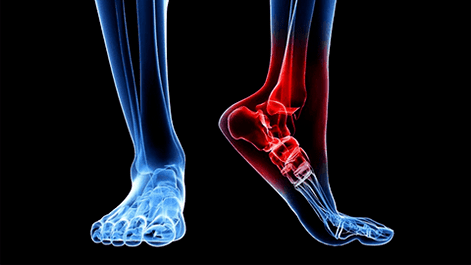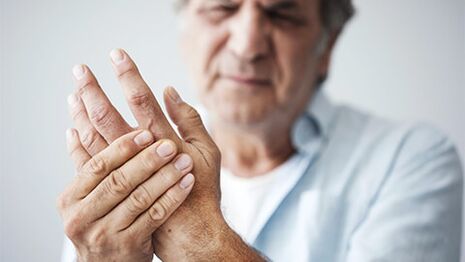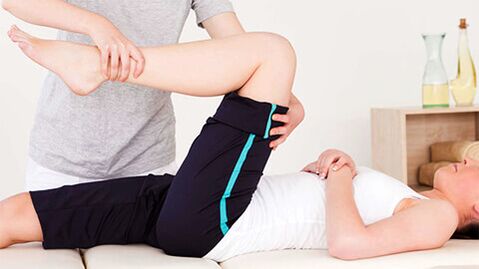
Arthritis is the entire deep malnutrition disease of arthritis, with various causes, but with similar pathological changes in clinical conditions.The articular cartilage, followed by drunken bone tissue, joint capsule and ligament instrument, exposed to destruction and deformation.The disease is performed chronically and without proper treatment can significantly limit the patient's motor activity.
Diagnosis and treatment of pathology are involved in arthrologists, rheumatologists, surgeons, orthopedics.
General information
Arthritis is diagnosed in about a fifth of the population on Earth, but the disease is more characterized.This proves the statistics of its spread across ages:
- Young people are up to 40 years old, no more than 6-7%;
- 45 years later to 20-25%, mature face;
- 70 years later - up to 80%.
The disease affects tissues under constant load: the small joints of the hands as well as the legs and knees, the areas of the spine and spine, the areas of the spine and chest, the ankle and shoulder joints less frequently.
notes!In women, the frequency of failed hand interaction joints occurs 10 times more frequently than that of men.
In many Western countries, the term "arthritis" is not used, but the concept of "arthritis" is replaced.Such an alternative is very reasonable because in most cases the inflammatory process is preceded by arthritis or accompanied by inflammation.In domestic medicine, the terms "joint" and "arthritis" basically mean the same disease, but the causes of the process are different.In addition, the concepts of osteoarthritis, osteoarthritis, deformation osteoarthritis are used to specify pathology.
notes!The difference between arthritis and arthritis lies in the cause of the disease.In the first case, these are the inflammatory processes (suffix - meaning inflammation) in the second metabolic disease (protein, mineral).
Developmental mechanisms and causes of joints
The main cause of arthritis is the violation of balance during the anabolic and catabolism of cartilage and bone tissue.If the integrated process normally prevails, the damage process will be faster during joint changes.As a result, rapid aging and degeneration of tissue structures were observed.They first start to collapse at the cellular level and then at the organ sound.The first destructive change occurred:
- The cloud of cartilage;
- superficial cations;
- microcracks and tears;
- The focus of the cartilage layer is generally sparse.
Cartilage loses its natural elasticity and density and no longer serves as a shock absorber during movement.The mutual correspondence of the joint surface shapes is disturbed, resulting in deformation of the connection.This aggravates the development of pathological changes and triggers many irreversible processes.In exchange for lost cartilage, bone tissue begins to grow as the peak and product forms, while stimulating movement and subsequently lead to severe disability in the patient.
The reason for this situation:
- Behaviors that invade mineral metabolism can lead to gout changes in joints, osteoporosis, etc.
- The disadvantage of tissue nutrition is venous stagnation, and poor microcirculation slows down blood supply and lymphatic drainage.The mineral components of the bones are depleted, become bone pores, and lose the ability to self-adjust.This phenomenon is characterized by lack of exercise, vascular pathology and hormonal failure.
- Inflammation process - Acute infectious disease, the result of hypothermia of the body, and impaired hormone background.
- The autoimmune response is a chronic focus of inflammation, nerve stress, endocrine pathology and other causes that can stimulate the attack of the body's immune system on its own cells, including joint tissue.The most common autoimmune lesions, rheumatoid arthritis, scleroderma, and lupus red.
- Increased joint wear - The mismatch between function and load slows down the synthesis process and accelerates damage.This phenomenon is characterized by athletes, dancers, overweight people and everyone who engages in large amounts of physical labor or is associated with long-term static loads (stand-standing work).
- Injury - bruising, dislocation, breaking, penetrating wounds, tears - violates the structure of the tissue and brings momentum to the beginning of deformation.
- Genetically determined pathology - Connective tissue dysplasia, invasion of collagen synthesis initially forms unstable low-function joints.
Some reasons echo closely with each other and form complex pathological complexes.
attention!Hormone bias plays a particularly important role in violating bone tissue metabolism.Thyroid failure, menopause, taking contraceptives, corticosteroids – all of which are direct paths to bone and bone changes in joints.
Changeable classification
In the systematics of arthritis, several definition criteria are used: cause and cause, localization, coverage area.
Etiology:
- Primary arthritis - independently developed, with damage to completely healthy joints without previous pathological involvement;
- The secondary person is formed in the case of disease (gout, psoriasis, rheumatism) and present joint deformation or injury.
By coverage:
- Local forms to a limited number of joint damage: monoarthrosis 1 joint, less absent arthritis 2-3;
- When there are 3 large structures and more involved in the pathology process, the generalized form is multiple types of polyarthritis.
According to the positioning of this process, the joint name of each joint is given separately:
- COKSARTROSIS-Disable hip joint connection;
- Spinal arthritis - affects intervertebral discs, mainly cervical, chest and lumbar spine;
- Adenotropic cancer - impaired working of the knee joint; one of the most common species;
- Crusa disease - participates with the pathological process of the ankle.
Articity can be progressive quickly or slowly, compensatory or compensatory.
Main symptoms and signs
Arthritis is a complex disease.Traditionally, it can be divided into several pathology that combine with each other:
- Chonditis and chondrosis - inflammatory and degenerative lesions of cartilage tissue;
- Osteoporosis is also an osteoporosis - a pathological process in bone structure;
- Synovitis - the involvement of lining of the joint capsule;
- BURSIT-General inflammation of joint bags;
- Reactive impairment of soft tissue in adjacent areas - affecting muscles, ligaments, fibers.

Observe them simultaneously or selectively according to stage, degree and shape.With this in mind, a series of symptom changes have been formed.Among them:
- Pokhrutzhazing is the first sign of invasion of mineral metabolism and disease.It can occur at any age.
- Inventory - strongly expressed in the morning.It is short-term and can be expressed through the effects of blocking joints.
- Limit liquidity - Reduce the magnitude of movement during active or passive action commissions.
- Pain relief is a different manifestation, starting with unpleasantness and soreness, after a strong load, it acquires background characteristics and ends with acute sharp and sharp movements.SO is known as "initiation pain" in particular, and manifests itself after a prolonged rest until the joints fully develop.
- Swelling - Inflammation with soft tissue, synovitis, cystitis.
- Deformation - observed by complete degeneration of cartilage and lack of impact factor.
notes!The nodules of the jungle and Gaberden are characteristic signs of deformed joints.They are bone growth with bone plant processes.
Joint stages and degrees
In terms of the intensity of joint changes, four disease stages are distinguished:
- Stage 1 - Slight contamination of cartilage (violating the structure and function of collagen fibers).In X-rays, there is actually no picture to be seen.
- Stage 2 - The stinging pain of cartilage fabric in the joint lumen is as high as 50%.It is covered with cracks and there is a slight pain in the areas of damaged compounds.Bone plant complexes appear on X-rays; joint space slightly reduces its size.
- Stage 3 - The lesions of cartilage almost reach the bone base, and the joint space is reduced sharply.
- 4 stages - The cartilage is completely damaged, which leads to partial or complete degeneration of the synovial fluid, wear of bone tissue between each other and deformation of the compound.In some areas, sclerosis has changed.The extreme manifestation of arthritis is the fusion of ossification of joint tissue and structure and the complete loss of mobility.
In some sources, Phase 1 and Phase 2 are merged into one.
As the symptoms progress, a person suffers from sports activities.Given behaviors that violate joint functional performance, there are 4 possible levels of pathological development:
- 0 degrees - complete mobility and performance;
- 1 degree - The patient retains the ability to serve himself and express social activities but is unable to engage in labor activities;
- 2 Degrees - Difficulties in social activities are added to situations where labor activities are violated;
- 3 degrees - All types of activities are limited or completely impossible: labor, social and self-service; patients require ongoing care.
What are the possible complications
With austerity treatment, you can cause many unpleasant consequences:
- persistent pain syndrome;
- la way;
- Vertebrates (vertebral arthritis);
- Significant joint deformation;
- Ossification of completely fixed structure.
What is the investigation procedure included
To diagnose joint diagnosis, it is sufficient to undergo medical examination of tumor collection.In order to determine the extent of damage, an instrument inspection was performed.The main ways to get a clear disease:
- Radiography;
- CT, MRI;
- Ultrasound examination;
- Flashing picture;
- Diagnostic arthroscopy, used for biopsy of cartilage tissue and synovial fluid.
During acute inflammation, doctors prescribe other analyses: general blood tests, rheumatism, biochemistry (glucose levels, protein compounds, electrolytes).
treat
It is impossible to completely eliminate the disease.Timely joint treatment can help you maintain the function of joints, normal motor activities and prevent pain.To rule out complications, the first phase should be started.
Drug Therapyinclude:
- Anti-inflammatory drugs, mainly NSAID;
- Pain and inflammation intra-articular steroid block (with obvious synovitis, cystitis);
- Proteolytic Inhibitors - slow down and pause the process of destroying bones and cartilage;
- Reflux - Prevent muscle spasms;
- Vascular protectors and drugs improve blood microcirculation in affected tissues;
- Cartilage protectant;
- Synthetic alternatives for synovial fluids;
- Vitamin and mineral ingredients.

Physical Therapy ComplexParallel provisions are made to enhance the effect of drugs.Main physiotherapy:
- Magnetic therapy;
- Electrophoresis;
- uhf;
- mud;
- bath;
- massage;
- Exercise therapy and exercise therapy using special simulators.
Surgery- The only way to treat later when the cartilage tissue is completely destroyed.The following solutions to this problem are possible:
- Endoscopy - partial or complete replacement of joints through artificial analogs;
- Arthroscopy - Minimally invasive surgery can remove bone plants or partially replace cartilage;
- Joint fixation - The joint is closed and secured in the most convenient position; over time, the surface of the joint that is connected will grow.
Forecast
Arthritis does not threaten the patient's life, but the lack of treatment can significantly limit freedom of movement and worsen the quality of life.Timely and contractual treatment in the early stages can restore the joints to a healthy state.In other cases, the degeneration process can only slow down with the aid of conservative treatment and compensation for loss of function due to prosthetic limbs.
Prevent disease
Therefore, it is almost impossible to fully recover, so special attention should be paid to prevention.The main requirement is a healthy lifestyle and comprehensive treatment of the inflammatory process:
- Timely treatment of hypothermia and infectious diseases are not allowed;
- Avoid physical overload and long static loads;
- Maintain normal weight;
- Stick to the right diet – The balanced ingredients of vitamins and minerals are very important for the health of the musculoskeletal system.
- Completely (until fully recovered if possible), deal with any damage to the joints;
- Practice a systematic physical exercise to stimulate blood circulation (cycling, hiking, jogging, Scandinavian walking).
If you are at risk (older age, poor heredity, physical overload), be sure to have regular radiographic examinations.






















